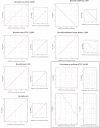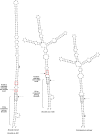Brucella microti: the genome sequence of an emerging pathogen
- PMID: 19653890
- PMCID: PMC2743711
- DOI: 10.1186/1471-2164-10-352
Brucella microti: the genome sequence of an emerging pathogen
Abstract
Background: Using a combination of pyrosequencing and conventional Sanger sequencing, the complete genome sequence of the recently described novel Brucella species, Brucella microti, was determined. B. microti is a member of the genus Brucella within the Alphaproteobacteria, which consists of medically important highly pathogenic facultative intracellular bacteria. In contrast to all other Brucella species, B. microti is a fast growing and biochemically very active microorganism with a phenotype more similar to that of Ochrobactrum, a facultative human pathogen. The atypical phenotype of B. microti prompted us to look for genomic differences compared to other Brucella species and to look for similarities with Ochrobactrum.
Results: The genome is composed of two circular chromosomes of 2,117,050 and 1,220,319 base pairs. Unexpectedly, we found that the genome sequence of B. microti is almost identical to that of Brucella suis 1330 with an overall sequence identity of 99.84% in aligned regions. The most significant structural difference between the two genomes is a bacteriophage-related 11,742 base pairs insert only present in B. microti. However, this insert is unlikely to have any phenotypical consequence. Only four protein coding genes are shared between B. microti and Ochrobactrum anthropi but impaired in other sequenced Brucella. The most noticeable difference between B. microti and other Brucella species was found in the sequence of the 23S ribosomal RNA gene. This unusual variation could have pleiotropic effects and explain the fast growth of B. microti.
Conclusion: Contrary to expectations from the phenotypic analysis, the genome sequence of B. microti is highly similar to that of known Brucella species, and is remotely related to the one of O. anthropi. How the few differences in gene content between B. microti and B. suis 1330 could result in vastly different phenotypes remains to be elucidated. This unexpected finding will complicate the task of identifying virulence determinants in the Brucella genus. The genome sequence of B. microti will serve as a model for differential expression analysis and complementation studies. Our results also raise some concerns about the importance given to phenotypical traits in the definition of bacterial species.
Figures




References
-
- Meyer KF, Shaw EB. A comparison of the morphologic, cultural, and biochemical characteristics of B. abortus and B. melitensis. J Infect Dis. 1920;27:173–184.
-
- Velasco J, Romero C, López-Goñi I, Leiva J, Díaz R, Moriyón I. Evaluation of the relatedness of Brucella spp. and Ochrobactrum anthropi and description of Ochrobactrum intermedium sp. nov., a new species with a closer relationship to Brucella spp. Int J Syst Bacteriol. 1998;48:759–768. - PubMed
-
- Scholz HC, Hofer E, Vergnaud G, Le Flèche P, Whatmore AM, Dahouk SA, Pfeffer M, Krüger M, Cloeckaert A, Tomaso H. Isolation of Brucella microti from Mandibular Lymph Nodes of Red Foxes, Vulpes vulpes, in Lower Austria. Vector Borne Zoonotic Dis. 2009;9:153–156. doi: 10.1089/vbz.2008.0036. - DOI - PubMed
Publication types
MeSH terms
Substances
Associated data
- Actions
- Actions
LinkOut - more resources
Full Text Sources
Molecular Biology Databases

